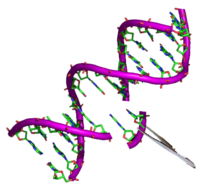
Photo from wikipedia
Prey around the world experience the risk of predation, and most have evolved constitutive and phenotypically plastic defences in response. Phenotypically plastic defences often come with trade-offs related to foraging,… Click to show full abstract
Prey around the world experience the risk of predation, and most have evolved constitutive and phenotypically plastic defences in response. Phenotypically plastic defences often come with trade-offs related to foraging, such that the magnitude of defence is mediated by body condition and food availability. Such adaptive responses are beneficial to prey, and there is an increasing appreciation that they can be disrupted by chemical compounds resulting from human activities. We examined predator-induced behaviours in freshwater snails (Physa acuta) using 32 combinations of different concentrations of olfactory predator cues, body condition and food availability to understand how they respond to the trade-off between avoiding predators and obtaining food. Using a subset of these conditions (16 environments), we then examined how snail responses were altered by increases or decreases in pH. We found that snails responded to increased predator cue concentrations with a shape consistent with a saturating response curve and that low body condition and low food availability weakened these responses. When we increased pH (from 7.8 to 9.5), snails exhibited weaker predator avoidance responses, but only in the absence of food. When we decreased pH (from 7.8 to 6.0), snails exhibited stronger predator avoidance responses and stronger declines in foraging, but only in the presence of food. Collectively, these results suggest that changes in pH due to acid mine drainage, eutrophication and ocean acidification may substantially alter the adaptive responses of aquatic animals. Future work should determine whether such info-disruption is common in other taxa, determine the underlying mechanisms and quantify the consequences of info-disruption to predator–prey and prey–resource interactions.
Journal Title: Animal Behaviour
Year Published: 2021
Link to full text (if available)
Share on Social Media: Sign Up to like & get
recommendations!